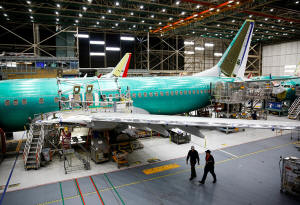How production pressures plunged Boeing into yet another crisis
 Send a link to a friend
Send a link to a friend
 [February 09, 2024] By
Valerie Insinna, Allison Lampert, David Shepardson and Tim Hepher [February 09, 2024] By
Valerie Insinna, Allison Lampert, David Shepardson and Tim Hepher
SEATTLE (Reuters) - In October, Boeing CEO Dave Calhoun was asked how
fast Boeing could raise output of its best-selling 737 MAX after a spate
of quality snags. He was upbeat: Boeing would get back to 38 jets a
month and was "anxious to build from there as fast as we can."
As he sought to reassure investors about the recovery of Boeing's cash
cow after another quarterly loss, one of the narrow-bodied jets was
waiting at Boeing Field in Seattle for final tests and delivery to
Alaska Airlines just six days later.
Four critical bolts were missing.
How a modern jetliner left Boeing's nearby Renton factory with a loose
door panel, setting the clock ticking on a terrifying mid-air blowout on
Jan. 5, has triggered soul-searching about quality controls and plunged
Boeing into its second safety crisis in five years.
Regulators have suspended Boeing's plans to ramp up 737 output and
Calhoun now says it's time to "go slow to go fast", casting doubt on the
shape of its recovery from back-to-back crises - first over two MAX
crashes that killed 346 people and then the pandemic - which left it $38
billion in debt.
Interviews with a dozen current and former industry executives suggest
it was the pressure to produce coupled with an exodus of experienced
workers that contributed to a slow-rolling industrial train wreck,
ending with 171 passengers staring out of a gaping hole at 16,000 feet.
"It looks like Boeing has been more focused on investing in ramping up
into higher production rates than taking its quality system to the next
level," said manufacturing expert Kevin Michaels, managing director of
aerospace consulting firm AeroDynamic Advisory in Michigan.
Two sources familiar with Boeing's quality division told Reuters that
controls had atrophied in recent years after many experienced inspectors
left during the pandemic and amid the pressure to stick to the
production recovery schedule.

While Boeing says it has added more inspectors since COVID, many were
inexperienced and checking work done by mechanics who themselves had
only recently been hired, the sources said, speaking on condition they
were not identified.
Asked for comment, Boeing referred Reuters to Calhoun's remarks last
month that it had "taken close care not to push the system too fast" and
had never hesitated to slow or halt production, nor stop deliveries, to
get things right.
The company says new manufacturing employees attend courses for 10 to 14
weeks then get 6 to 8 weeks of hands-on training. They are also required
to win certifications as they progress.
'WHO SIGNED OFF?'
Since the Alaska Airlines blowout, Boeing has also said it is
implementing plans to improve quality in its 737 system including more
inspections and has commissioned an independent study of quality
management.
The National Transportation Safety Board (NTSB) said on Tuesday the door
plug, which replaces an unused emergency exit in some planes, appeared
to be missing four key bolts.
U.S. Senator Tammy Duckworth, who chairs an aviation subcommittee, told
Reuters the NTSB's interim report raised serious questions about
Boeing's quality inspection processes.
"Why is it that nobody caught it? ... Who signed off on this work?" she
said.
The seeds of the problems that have beset Boeing were sown many years
before but accelerated after the crisis caused by the MAX crashes in
2018 and 2019 and the industry chaos during the pandemic that followed,
the industry executives said.
The fuel-saving Airbus A320neo and 737 MAX were launched in 2010 and
2011 into a hot aviation market fuelled by low interest rates, high oil
prices and the rise of low-cost Asian airlines.
For much of the last decade, orders to serve a global middle-class have
rained down on the two biggest planemakers, leading to a war for market
share and the long wait-times that executives say still underpin today's
pressure to produce.
To feed the surge in demand for the workhorse jets, Boeing and Airbus
have increasingly turned to the car industry for help in making their
factories and supply chains more efficient.

Both extracted a price from suppliers for joining the speeding train of
aerospace production: cheaper parts in exchange for high volume. Boeing
dropped a widely criticized supplier cost-cutting project during COVID
after years of what one former manager called an efficiency rallying
cry.
In his first public speech since the accident, Boeing's supply chain
chief Ihssane Mounir struck a collaborative note and urged suppliers to
speak up and join a forum of more than 30 companies set up to help
untangle supply chains.
MANUFACTURING DEFECTS
Airbus and others have also wrestled with quality and staff shortages as
the pandemic snapped an already stretched supply chain. Europe's
regulator last week called for inspections for microscopic gaps on the
A380 after a manufacturing flaw.
Speed alone was not the problem, experts say. Boeing had reached a peak
of 57 jets a month with fewer quality problems before the second of two
MAX crashes interrupted output in 2019.
But as Boeing gradually rebuilt production in the wake of the pandemic,
it grappled with a series of high-profile manufacturing defects which
slowed or, in the case of the 787 Dreamliner, even stopped airplane
deliveries.
[to top of second column] |

Two workers walk under the wing of a 737 Max aircraft at the Boeing
factory in Renton, Washington, U.S., March 27, 2019. REUTERS/Lindsey
Wasson/File Photo

In December, U.S. regulators said a foreign airline had found a bolt
with a missing nut in a MAX 737 rudder system and Boeing discovered
a case of a nut not properly tightened.
It was not until last month's blowout that financial and output
targets took a back seat and Boeing acknowledged errors, citing a
quality issue as carriers found yet more loose bolts.
Boeing will now be under pressure to connect the dots more quickly.
"There are signals but also a lot of noise," a person familiar with
internal briefings said, using the statistical jargon for separating
out meaningful information.
But the industry executives said there was no substitute for human
inspections and raised questions about the lingering effect of
previous cost cuts and Boeing's culture, which is already the
subject of a separate investigation by the U.S. Federal Aviation
Administration (FAA).
Ed Pierson, a former Boeing senior manager who was a whistleblower
during the 2018-2019 MAX crisis, said Boeing began cutting quality
inspections during his final years there, which ended in August
2018.
"The logic is, if you can remove those inspections, you can
accelerate production," he told Reuters.
THE CORRECT TORQUE
After the pandemic struck in 2020, Boeing, already reeling from the
MAX crisis, announced 30,000 layoffs in two stages.
Boeing and others are now trying to woo back workers but face a
brain drain just as output speeds up. This time, the well-worn
cyclical pattern of rehiring workers has been tough.
Boeing Commercial Airplanes CEO Stan Deal told staff last month it
had added 20% more inspectors since 2019 and would increase 737
inspections.
Labor headaches do not end there. According to the classic
manufacturing playbook, as production speeds up it must stay in sync
with the capacity of suppliers to provide parts and the familiarity
that workers develop as they repeat new tasks.
Getting this so-called learning curve wrong risks mistakes, waste
and cost - or in the worst case, safety.
"If I'm sitting there riveting something onto an airplane or an
airframe, or I'm bolting something into an airplane, there's got to
be at least one person coming after to me to inspect my work," said
Louis Gialloreto, associate professor and aerospace expert at
Montreal's McGill Executive Institute business school.
The torquing of bolts appears to be a case in point.
It has been at the center of past disputes between Boeing and unions
over efforts to be more efficient by reducing inspections and the
company issued a bulletin last week to suppliers laying out
practices to ensure bolts are tightened.
In 2019, during a visit by Reuters to a 787 plant in South Carolina,
Boeing demonstrated "smart" wrenches that tell machinists if they
are applying the correct torque. Boeing said this would allow some
secondary checks to be safely removed.

Boeing's machinist union warned at the time that the "Quality
Transformation" initiative would push defects down the production
line or delay deliveries and drive up work injuries.
Boeing's Deal said on Sunday it would speed up purchases of tools so
that all 737 workers have the right equipment.
TRAVELLED WORK
Getting the manufacturing balance right is all the more challenging
as jets and especially their increasingly customised cabins end up
in the wrong order because of missing parts.
A 737 moves one position down the production line every day
regardless of whether all work is performed. When parts are
unavailable, employees are forced to conduct out-of-sequence or
"travelled" work, meaning they have to bring tools to another part
of the line and finish work there, industry experts say.
Airbus has faced similar problems as it struggles to meet output
goals, according to a 2023 memo seen by Reuters.
On top of that, Boeing is wrestling with dozens of jets that weren't
delivered during MAX groundings, or as a result of U.S.-China
tensions, and must now be reworked.
On Sunday, Boeing called time on travelled work, though many
industry experts say that will be no easy task. "We need to perform
jobs at their assigned position," Boeing's Deal said.
Representative Rick Larsen, the top Democrat on the House
Transportation Committee, backs the FAA's unusual cap on Boeing
production even though it affects his Washington State district.
"That's the way it's going to have to be because Boeing has earned
this attention for all the wrong reasons," he said.
(Reporting by Valerie Insinna in Seattle, Allison Lampert in
Montreal, David Shepardson in Washington and Tim Hepher in Paris;
Additional reporting by Abhijith Ganapavaram in Bengaluru and
Padraic Halpin and Conor Humphries in Dublin; Writing by Tim Hepher;
Editing by David Gaffen and David Clarke)
[© 2024 Thomson Reuters. All rights
reserved.]
This material may not be published,
broadcast, rewritten or redistributed.
Thompson Reuters is solely responsible for this content.
 |